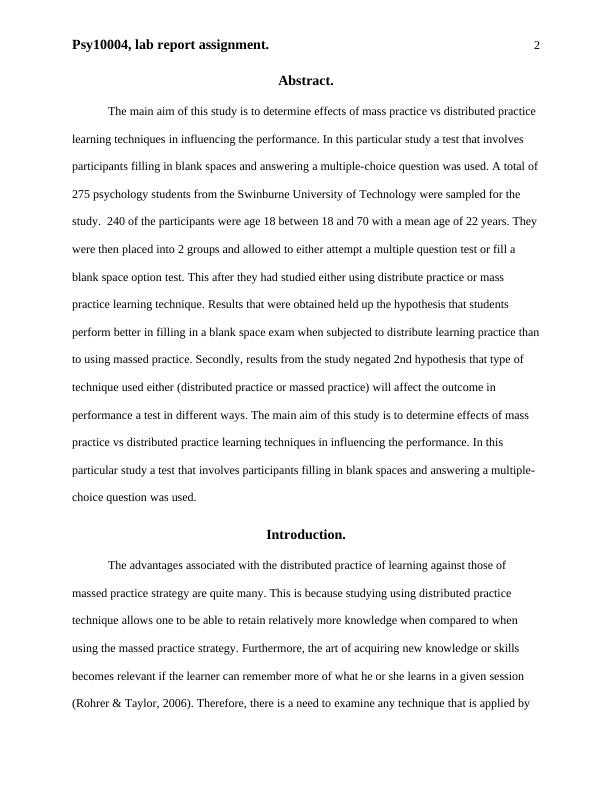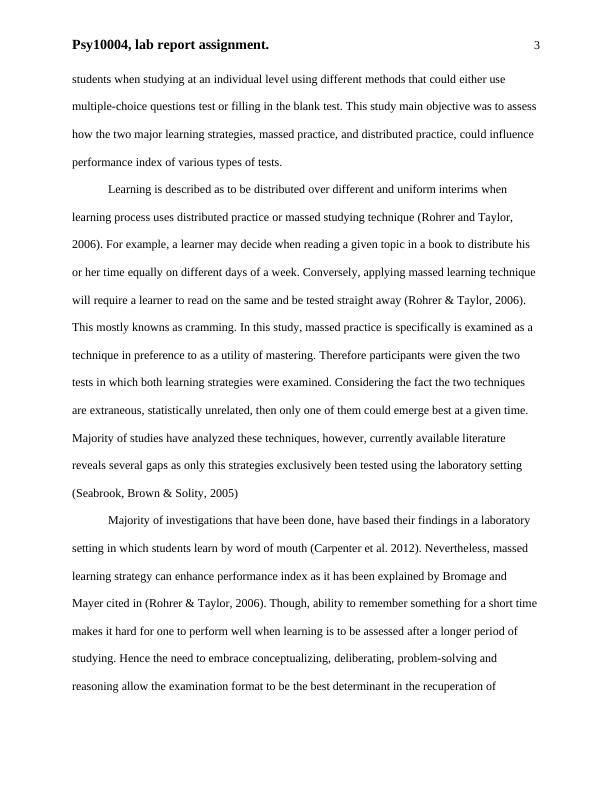Mass Practice vs Distributive Practice Learning Techniques
This lab report examines the effects of two different studying techniques on people’s test performance: massed vs. distributed practice.
13 Pages2773 Words29 Views
Added on 2022-08-18
Mass Practice vs Distributive Practice Learning Techniques
This lab report examines the effects of two different studying techniques on people’s test performance: massed vs. distributed practice.
Added on 2022-08-18
ShareRelated Documents
Running head: Psy10004, lab report assignment. 1
Assignment 1: Lab report:
Name:
eLA's name:
Assignment due date:
Assignment 1: Lab report:
Name:
eLA's name:
Assignment due date:

Psy10004, lab report assignment. 2
Abstract.
The main aim of this study is to determine effects of mass practice vs distributed practice
learning techniques in influencing the performance. In this particular study a test that involves
participants filling in blank spaces and answering a multiple-choice question was used. A total of
275 psychology students from the Swinburne University of Technology were sampled for the
study. 240 of the participants were age 18 between 18 and 70 with a mean age of 22 years. They
were then placed into 2 groups and allowed to either attempt a multiple question test or fill a
blank space option test. This after they had studied either using distribute practice or mass
practice learning technique. Results that were obtained held up the hypothesis that students
perform better in filling in a blank space exam when subjected to distribute learning practice than
to using massed practice. Secondly, results from the study negated 2nd hypothesis that type of
technique used either (distributed practice or massed practice) will affect the outcome in
performance a test in different ways. The main aim of this study is to determine effects of mass
practice vs distributed practice learning techniques in influencing the performance. In this
particular study a test that involves participants filling in blank spaces and answering a multiple-
choice question was used.
Introduction.
The advantages associated with the distributed practice of learning against those of
massed practice strategy are quite many. This is because studying using distributed practice
technique allows one to be able to retain relatively more knowledge when compared to when
using the massed practice strategy. Furthermore, the art of acquiring new knowledge or skills
becomes relevant if the learner can remember more of what he or she learns in a given session
(Rohrer & Taylor, 2006). Therefore, there is a need to examine any technique that is applied by
Abstract.
The main aim of this study is to determine effects of mass practice vs distributed practice
learning techniques in influencing the performance. In this particular study a test that involves
participants filling in blank spaces and answering a multiple-choice question was used. A total of
275 psychology students from the Swinburne University of Technology were sampled for the
study. 240 of the participants were age 18 between 18 and 70 with a mean age of 22 years. They
were then placed into 2 groups and allowed to either attempt a multiple question test or fill a
blank space option test. This after they had studied either using distribute practice or mass
practice learning technique. Results that were obtained held up the hypothesis that students
perform better in filling in a blank space exam when subjected to distribute learning practice than
to using massed practice. Secondly, results from the study negated 2nd hypothesis that type of
technique used either (distributed practice or massed practice) will affect the outcome in
performance a test in different ways. The main aim of this study is to determine effects of mass
practice vs distributed practice learning techniques in influencing the performance. In this
particular study a test that involves participants filling in blank spaces and answering a multiple-
choice question was used.
Introduction.
The advantages associated with the distributed practice of learning against those of
massed practice strategy are quite many. This is because studying using distributed practice
technique allows one to be able to retain relatively more knowledge when compared to when
using the massed practice strategy. Furthermore, the art of acquiring new knowledge or skills
becomes relevant if the learner can remember more of what he or she learns in a given session
(Rohrer & Taylor, 2006). Therefore, there is a need to examine any technique that is applied by

Psy10004, lab report assignment. 3
students when studying at an individual level using different methods that could either use
multiple-choice questions test or filling in the blank test. This study main objective was to assess
how the two major learning strategies, massed practice, and distributed practice, could influence
performance index of various types of tests.
Learning is described as to be distributed over different and uniform interims when
learning process uses distributed practice or massed studying technique (Rohrer and Taylor,
2006). For example, a learner may decide when reading a given topic in a book to distribute his
or her time equally on different days of a week. Conversely, applying massed learning technique
will require a learner to read on the same and be tested straight away (Rohrer & Taylor, 2006).
This mostly knowns as cramming. In this study, massed practice is specifically is examined as a
technique in preference to as a utility of mastering. Therefore participants were given the two
tests in which both learning strategies were examined. Considering the fact the two techniques
are extraneous, statistically unrelated, then only one of them could emerge best at a given time.
Majority of studies have analyzed these techniques, however, currently available literature
reveals several gaps as only this strategies exclusively been tested using the laboratory setting
(Seabrook, Brown & Solity, 2005)
Majority of investigations that have been done, have based their findings in a laboratory
setting in which students learn by word of mouth (Carpenter et al. 2012). Nevertheless, massed
learning strategy can enhance performance index as it has been explained by Bromage and
Mayer cited in (Rohrer & Taylor, 2006). Though, ability to remember something for a short time
makes it hard for one to perform well when learning is to be assessed after a longer period of
studying. Hence the need to embrace conceptualizing, deliberating, problem-solving and
reasoning allow the examination format to be the best determinant in the recuperation of
students when studying at an individual level using different methods that could either use
multiple-choice questions test or filling in the blank test. This study main objective was to assess
how the two major learning strategies, massed practice, and distributed practice, could influence
performance index of various types of tests.
Learning is described as to be distributed over different and uniform interims when
learning process uses distributed practice or massed studying technique (Rohrer and Taylor,
2006). For example, a learner may decide when reading a given topic in a book to distribute his
or her time equally on different days of a week. Conversely, applying massed learning technique
will require a learner to read on the same and be tested straight away (Rohrer & Taylor, 2006).
This mostly knowns as cramming. In this study, massed practice is specifically is examined as a
technique in preference to as a utility of mastering. Therefore participants were given the two
tests in which both learning strategies were examined. Considering the fact the two techniques
are extraneous, statistically unrelated, then only one of them could emerge best at a given time.
Majority of studies have analyzed these techniques, however, currently available literature
reveals several gaps as only this strategies exclusively been tested using the laboratory setting
(Seabrook, Brown & Solity, 2005)
Majority of investigations that have been done, have based their findings in a laboratory
setting in which students learn by word of mouth (Carpenter et al. 2012). Nevertheless, massed
learning strategy can enhance performance index as it has been explained by Bromage and
Mayer cited in (Rohrer & Taylor, 2006). Though, ability to remember something for a short time
makes it hard for one to perform well when learning is to be assessed after a longer period of
studying. Hence the need to embrace conceptualizing, deliberating, problem-solving and
reasoning allow the examination format to be the best determinant in the recuperation of

Psy10004, lab report assignment. 4
information (Stanger-Hall, 2012). Hence this investigation specifically aimed at examining the
techniques distributed and massed practices using filling in blank tests and multiple-choice tests
as parameters to test our hypothesis. As per (Stanger-Hall, 2012), multiple-choice test can easily
mislead or alter information and understanding of concepts. Furthermore, it only of advantage
for a shorter time between studying and evaluation. Though an evaluation using filling blank
space requires one to critically reason out to solve the problems in question (Stanger-Hall, 2012)
and therefore can be applied in assessing several thinking skills as learners deliberate
individualized answers.
This study was also framed to expound more on findings obtained from a previous
research, by using similar features of distributed and massed studying strategies described in
(Rohrer and Taylor (2006). Besides this investigation replicates and extends proposals of
(Goossens et al. 2016) on use of multiple-choice test and filling in blank space test in observing
influence of spacing on studying as a common determinant of performing in both tests. Hence a
hypothesis that students will perform better in the filling in the blank test when using distributed
practice technique compared to massed practice. As well it was hypothesized that type of
technique employed to study (massed practice or distributed practice would affect performance
index of either test in different ways.
Method.
Participants.
The study used 275 participants in evaluating influence of mass vs distributed learning
techniques on performance index of students. These participants were psychology student’s
pursuing an online course using the Swinburne Psychology Research Program. To ensure our
data was reliable, authentic and of validity, results for 36 students from our sample were not used
information (Stanger-Hall, 2012). Hence this investigation specifically aimed at examining the
techniques distributed and massed practices using filling in blank tests and multiple-choice tests
as parameters to test our hypothesis. As per (Stanger-Hall, 2012), multiple-choice test can easily
mislead or alter information and understanding of concepts. Furthermore, it only of advantage
for a shorter time between studying and evaluation. Though an evaluation using filling blank
space requires one to critically reason out to solve the problems in question (Stanger-Hall, 2012)
and therefore can be applied in assessing several thinking skills as learners deliberate
individualized answers.
This study was also framed to expound more on findings obtained from a previous
research, by using similar features of distributed and massed studying strategies described in
(Rohrer and Taylor (2006). Besides this investigation replicates and extends proposals of
(Goossens et al. 2016) on use of multiple-choice test and filling in blank space test in observing
influence of spacing on studying as a common determinant of performing in both tests. Hence a
hypothesis that students will perform better in the filling in the blank test when using distributed
practice technique compared to massed practice. As well it was hypothesized that type of
technique employed to study (massed practice or distributed practice would affect performance
index of either test in different ways.
Method.
Participants.
The study used 275 participants in evaluating influence of mass vs distributed learning
techniques on performance index of students. These participants were psychology student’s
pursuing an online course using the Swinburne Psychology Research Program. To ensure our
data was reliable, authentic and of validity, results for 36 students from our sample were not used

End of preview
Want to access all the pages? Upload your documents or become a member.
Related Documents
Effect of Distributed vs Massed Learning on Memory and Recalllg...
|11
|2858
|144
Effect of Distributed Practice vs Massed Practice on Learning: Lab Report Assignmentlg...
|15
|3717
|222
Effect of Massed Practice vs Distributed Practice on Test Performancelg...
|11
|2602
|441
Massed Vs. Distributive Practices Assignmentlg...
|12
|3581
|43
PSY10004: Psychology Lab Reportlg...
|5
|1154
|533
Mass VS Distributive Learning Assignmentlg...
|11
|3033
|98
